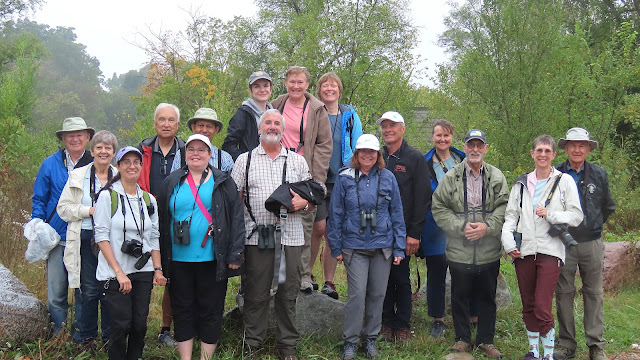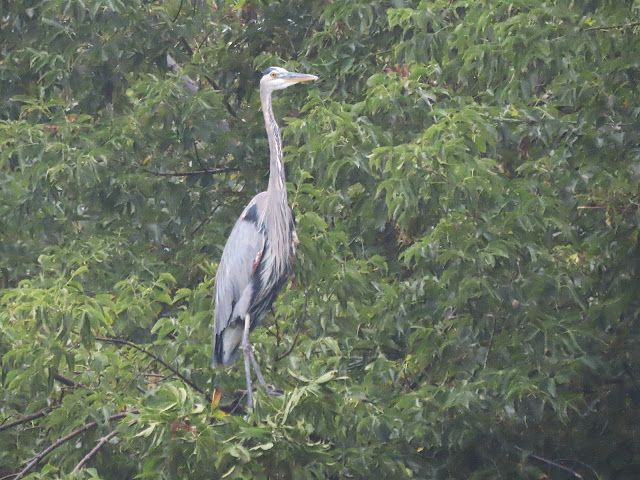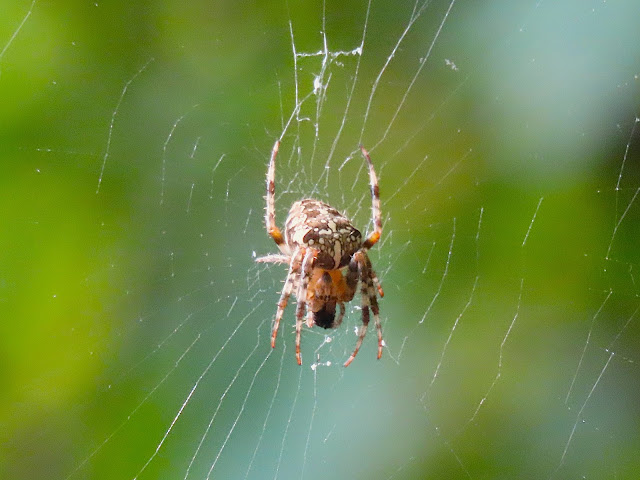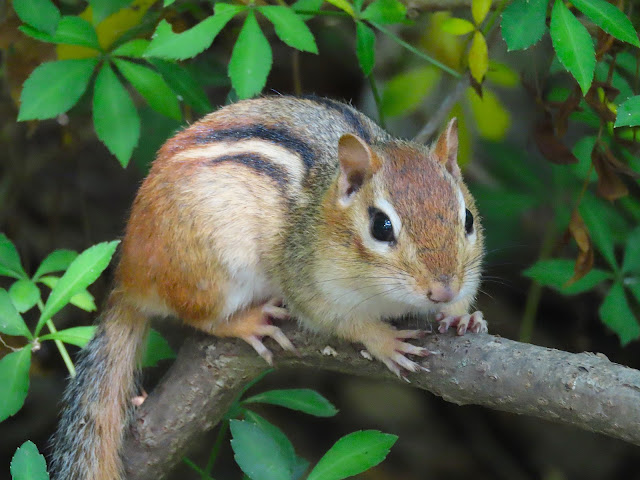Leader: David M. Gascoigne
Members: Miriam Bauman, Dave Collins, Mary Collins, Lisa Den Besten, Heather DeYoe, Helen Fowler, Steve Gyorffy, Leon Linseman, Curtiss MacDonald, Kuldip Malhotra, Melinda Metzger, Geoff Moore, Ruthann Moore, Pamela Sadler
Guests: Ellen Klein
DesJardins Canal, Dundas, ON
It was a little dull when we set out, and we had brief periods of rain, but we were not to be deterred. Conditions for photography were less than ideal; it is an old truism, however, that you can't change the weather, so we pressed on.
The target bird at this location in September is Black-crowned Night Heron (Nycticorax nycticorax) and in no time at all we found a juvenile.
There were several novice birders on this outing, so this species was a "lifer" for many of them. That always adds an extra degree of satisfaction for the leader.
As might be expected, Mallards (Anas platyrynchos) were ubiquitous, but no less lovely for their familiarity.
To listen to a group of birders give directions to each other is sometimes a lesson in hilarity. "It's over there," one will say. "Where?," asks another. "In that tree." "No not that one, the one next to it." "High up in the lower brown dead stuff." "Where?" "On the branch!" One way or another we always make sure that everyone sees the bird.
Having located at least two juvenile Black-crowned Night Herons we then found an adult.
It was a morning for herons. Down in the corner, hard by Olympic Drive, we caught sight of a Great Blue Heron (Ardea herodias).
Today Hermes was doubtless smiling on us, for in mere moments we added Green Heron (Butorides virescens) to complete a trifecta.
Goldenrod (genus Solidago) looked splendid.
Photo credit: Dave Collins
We all heard the characteristic rattle of a Belted Kingfisher (Megaceryle alcyon) as it flew by us at high speed, but very obligingly it perched in a convenient spot.
Photo credit: Dave Collins
Land snails in the genus Cepaea were abundant.
These are either Brown-lipped or White-lipped Snail, but I'm damned if I can ever tell the difference!
It was Tina's sharp eyes that picked up yet another Green Heron.
I think we all deserve heron patches to sew on our clothing or backpacks, and I am quite sure Lisa will be organizing this without delay!
Urquart Butterfly Gardens, Dundas, ON
The butterfly gardens were a riot of colour - sensory overload of the very best kind.
The people responsible for these gardens deserve a good deal of praise, and I am especially happy to see Fred Urquart, a true Canadian hero, memorialized in this way.
It will be a happy gang of Cedar Waxwings (Bombycilla cedrorum) who first happen on this Guelder-Rose (Viburnum opulus) - unless American Robins (Turdus migratorius) beat them to the punch that is!
We were greeted by a tree full of Turkey Vultures (Cathartes aura) enjoying the sun that was now breaking through.
The marsh is adjacent to a very large cemetery and the presence of congregations of vultures always adds a sense of the macabre.
A Great Egret (Ardea alba) - our fourth heron species - seemed to be having a chat with a Double-crested Cormorant (Nannopterum auritum).
Ring-billed Gulls (Larus delawarensis) were loafing peacefully as only gulls can.
Photo credit: Dave Collins
A Green-winged Teal (Anas carolinensis) is an exceptionally appealing little duck. Several were spotted quite far out, but this individual was close by and cooperative.
A couple of Trumpeter Swans (Cygnus buccinator) preened and primped and never really gave us a great look.
A Mallard and a Green-winged Teal were happy to hang out together.
In recent years Great Egrets have become more and more common, and there were several in different parts of the marsh. No doubt a high perch confers an advantage - or so this individual seems to think!
It will not be long before Ospreys (Pandion haliaeetus) will all have departed for their winter quarters in the south, but this individual still patrolled the water searching for a meal.
A Grey Catbird (Dumetella carolinensis) remained mostly hidden but revealed itself briefly before disappearing again.
New England Asters (Symphyotrichum novae-angliae) are just one of the reasons why Ontario is a very special place.
There were not many birds out on the water, so this Double-crested Cormorant received extra attention.
This infestation of Wooly Alder Aphid (Prociphilus tessellatus) was quite visible to the naked eye, even at some distance.
Interestingly, we spotted an Oblique Streaktail (Allograpta obliqua) right afterwards, an insect known to feed on aphids.
You don't see much of this well-hidden spider, but I believe that it is a Lattice Orbweaver (Araneus thaddeus).
I was interested to see this unit, recently installed, to encourage fisherfolk to responsibly dispose of unwanted fishing line, the scourge of birds and small mammals.
A pure white form of a Mallard that has been selectively bred by humans is very attractive. It is generally known as a Pekin Duck.
Eastern Chipmunks (Tamias striatus) were ubiquitous, always on the hunt for a human laden with peanuts or other tasty treats.
A lone male Ruddy Duck (Oxyura jamaicensis) was a very agreeable discovery - and another lifer for several members of the group.
And to round out the walk as we strolled back to the car, a Typical Funnel Weaver (family Agelenidae).
Paletta Park, Burlington, ON
Like other locations, the passage of migratory songbirds was virtually non-existent at Paletta, and there does seem to be a general reduction in numbers this fall. This is, of course, in line with the alarming declines of bird populations overall, a universal phenomenon.
A Double-crested Cormorant perched delightfully, in full sun, on a high branch.
A Song Sparrow (Melospiza melodia) was having a vigorous bath, and we all enjoyed seeing the sheer ebullience with which it went about its task.
We were greeted by a very handsome Ring-billed Gull.
The aim of our quest at Bronte was Red-necked Grebe (Podiceps gisegena) and we were royally rewarded, as an adult and a well-developed youngster put on quite a show for us.
Carolina Grasshoppers (Dissosteira carolina) were hopping all over the rocks, no doubt providing nutritious food for the gulls.
Adult grebes are known to provide feathers to their young to be swallowed as a stomach lining, to protect against penetration by sharp fish bones. We were elated to see this exchange taking place.
People install decoy owls around their boats in the harbour and they are quite useless. I think it takes the gulls an hour at most to figure out that the owl is not real and they waste no time in perching next to it.
This was our final stop on what had overall been a very fine day, with many highlights, not least of which was the sheer enjoyment of being with like-minded people.
Let's do it again soon!































































































I'm so impressed of all the photos you show today, David. The birds are beautiful, and the flowers are lovely. The Bittersweet Nightshade is very beautiful indeed.
ReplyDeleteHugs and kisses, Marit
I thoroughly enjoyed your excellent photos and everything so nicely identified. Thank you for sharing it all.
ReplyDeleteMy pleasure, Stephanie. I am unable to find your blog - please send me the link so that I may visit.
Delete💐༶⋆🌺˙⊹☀️🌿 Hi David, how r u!
ReplyDelete🌺🌺What a chronicle so full of natural wonders. It´s admirable how you capture the essence of a day of bird watching, interweaving not only the fauna, but also the companionship and camaraderie that develops among the observers. I feel the enthusiasm shared there even if the sky is gray.
The flowers, the butterfly gardens, the swans, the squirrels and the snails fascinate me, everything is actually a song to life. Appreciate that you share so much joy surrounded by friends and winged and non-winged beings.
Sending gros bisous
have a great saturday.
So many wonderful critters and I don't know many of them. The colours in the butterfly gardens is just amazing!
ReplyDeleteYour photography is always a treat
ReplyDeleteWhat a beautiful series of photos of your walk with all the birdwatchers.
ReplyDeleteI think the dahlias are beautiful as are the swans.
I enjoyed your blog, fortunately I now understand what it is about thanks to google translate.
I wish you a beautiful Sunday.
Greetings Irma
Wow, awesome post and a great report on your outing. The birds are all wonderful sightings, it has been awhile since I have seen an Osprey. I assume they all left. The flowers and garden are beautiful. Great collection of photos. Take care, have a great day and a happy week ahead.
ReplyDeleteThanks for taking us along, wonderful photos of everything.
ReplyDeleteA wonderful day was had by all! Thanks for showing us the highlights!
ReplyDeleteToo bad you couldn't have joined in person, Shari.
DeleteComienza tu reportaje, con una buena fotografía de grupo. Seguro que todos lo han pasado muy bien, en el recorrido y capturando las preciosas imágenes, que ahora acabo de ver.
ReplyDeleteQue tengas una buena semana.
Comienza tu reportaje, con una buena fotografía de grupo. Seguro que todos lo han pasado muy bien, en el recorrido y capturando las preciosas imágenes, que ahora acabo de ver.
ReplyDeleteQue tengas una buena semana.
Walking in the rain can be an incredibly pleasant experience. You saw a lot of very interesting birds. I love flowers. I was delighted by the New England Asters, beautiful zinnias and the rarely seen Solanum dulcamara.
ReplyDeleteDavid, all the presented photos are very beautiful.
Have a great autumn week.
A huge report and not only for its length, but for the variety and quality of the photographs.
ReplyDeleteIt sure was a magnificent day in good company.
What a beautiful variety of photos, it's always a pleasure to see them.
ReplyDeleteHello David,
ReplyDeletewith so many naturalists with cameras, only a good story with great photos could come out of it..thanks to everyone for the pictures
Greetings Frank
What a fabulous outing! I like seeing the train go by and love the birds you saw. The Green Heron is a favorite here in our swamps. Enjoy your day!
ReplyDeleteAmazing photos David. Loving the spiders and snails. And all those birds! Good to see photos of the gulls. I really like gulls, I think I must be the only person in Scotland that does!
ReplyDeleteThere are maybe two of you, Ananka. I know of another Scottish blogger who is a gull enthusiast.
DeleteIt was a pleasure to look at the wonderful photos. Such bird paradises should exist here in Finland as well.
ReplyDeleteEasy to see that in your country there are many beautiful places. I think that walking along those natural paths is a pleasant experience. I enjoyed all your wonderful photos. The pictures of the snails and the squirrel are absolutely stunning.
ReplyDeleteHi David – what a great group you had - how lucky you were to find the juvenile so quickly … then another and the adult – clever Miriam – and for all the other shots you've given us. Gorgeous Butterfly Gardens.
ReplyDeleteKilldeer – such an odd name for a shore bird … but I note given by Linnaeus … that photo is a delight with its reflection.
The Oblique Streaktail is in for a gorging time … that infestation is 'fascinating'!! Also I enjoy seeing the spiders … extraordinary creatures … as too is that stand of Tall Blue Lettuce; I used to love seeing the Woodpeckers when I was over on the west coast.
Interesting to know about the grebes and their feather offerings … I'd not heard that before …
Oh I agree – being in and around like-minded people … thanks for this pick-me-up – cheers Hilary
Great to hear from you, Hilary.
DeleteJeanie often posts photos of herons in Michigan, too. I never tire of seeing these photos. No herons in Hawaii. I love swans, too. I saw them at the Regent Hotel on Maui, swimming in the man made pond.
ReplyDeleteThe butterfly garden in Dundas looks interesting. I'll be in the area in a couple of weeks at Thanksgiving, my son and family live nearby, so I may have time to go to Dundas to check it out. I'm quite often in Dundas visiting a friend, it's a lovely town.
ReplyDeleteThe butterfly garden will, of course, be past its prime, but if you visit that area frequently be sure to check back in the spring. In the meantime the adjacent canal is well worth a visit.
DeleteI've only seen a kingfisher once and that was on the Rio Grande in Big Bend. lots of great photos as usual.
ReplyDeleteAnd in that part of Texas three you might have encountered Green Kingfisher or Ringed Kingfisher, in addition to the more common Belted Kingfisher.
ReplyDeleteWhat an amazing day out you are so lucky to have so many nearby places to go to. The Night Heron and the Song Sparrow are my favourites but I could comment on every single photo, an excellent choice photos and info.
ReplyDeleteI am sorry I seem to be getting further and further behind we just seem so busy!!
Bisous mon ami, Diane
What a great outing. You saw so many birds!
ReplyDeleteWhat a great series of birds, ducks, flowers, etc..... And even a chipmunk! Hard to know where to start.
ReplyDeleteGlad you found your hair in and many more.
There were many firsts for me. I have painted a belted kingfisher but have never seen one.
That was quite a collection of Wooly Aphids..The Streaktail Will be well fed for some time to come. I didn,
't know that webbed feet could perch in a tree.
The little sparrow seems to be having a grand time. I'm just glad that he's not emptying my birdbath.
So many snails. I didn't realize that they were different colors until I saw them on a bigger screen.
Interesting about the Grebe and the feathers. Smart little duckies! An instinct provided by mother nature, I assume.
Somebody has made a lot of money selling those decoy owls that don't seem to do much good.
I thoroughly enjoyed this outing.xxxooo
Missy
This is a fantastic series of photos. The birds are beautiful, but I also like the detail on the snail. And you are right....retirement is the best!
ReplyDeleteGreat shots! I did not know that a duck would eat feathers to protect its stomach lining. That’s amazing.
ReplyDeleteThe fishing line containers are a popular project here for teenage Boy Scouts working on a service badge. They use a section of plastic pipe. These are often installed at public boat landings or in parks.
They are not ducks, Linda; they are grebes - totally different family of birds.
DeleteHello David, so sad you live so far away. Otherwise I would have loved to join you on this trip. What a beautiful place and what an amazing birds you encouterd. Even a Osprey!. The photos are amazing as always.
ReplyDeleteTake care,
Love Roos
Wouldn’t it be wonderful if we could take a walk together? We’d be so engrossed we might never come home!
DeleteI will second your comment about retirement, David, as Michelle did before, because how else could a group go out for so much pleasure in all these sightings. Glad the weather improved as the outings went along although overcast days are often quite welcome, but perhaps not when taking gird photos. The snails and chipmunk were a nice change in amongst the birds and the young grebe taking the feather from the parent must certainly have been quite an amazing exchange to not only see but photograph. And, how interesting to learn that it protects the bird's stomach from fish bones.
ReplyDeleteKolejna udana wycieczka. Bardzo podziwiam, że nic nie ujdzie Waszej uwadze. Ptaki na drzewach i w wodzie, ssaki, owady, kwiaty dzikie i ogrodowe. Wyobrażam sobie ile motyli tam jest w słoneczny dzień.
ReplyDeleteYou will have to visit Ontario, Ludmila. Then we’ll go exploring together.
DeleteDavid - it has been a while since I visited, but I have not forgotten the treasure that is always offered by one of your posts! What a terrific variety of birds and other critters! The Kingfisher and the snails were the highlights for me! And I smiled at your comment about the gulls ignoring the (fake) owl!
ReplyDeleteThanks for stopping by, Angie.
DeleteSuch a good outing and I did enjoy all of these great photographs.
ReplyDeleteAll the best Jan
ReplyDeleteHello David, it's good that they are doing group outings there with people who enjoy the appreciation of nature.
A beautiful wetland they visited.
Lots of flowers, insects and birds; I liked the herons and especially the grebe scene. I just returned from an expedition through Chaco.
Greetings
Querido amigo David, un placer como siempre de pasear contigo. Gracias y abrazos.
ReplyDeleteLike usual, I learned something new today, David - I had no idea tht grebes feed feathers to their young for lining their stomach. Interesting.
ReplyDeleteI do like the fishing line recycle container. We could use one at our lake as well. They put up signs to remind fishermen not to leave behing their fishing lines, but I still see so many hanging from trees or just left on the ground.
Oh the Black-crowned Night Herons. Every time I see one at the lake, it captures my heart. So do the Green Herons.
Beautiful photos - thank you! Hugs - Carola
Dear David,
ReplyDeleteI am also familiar with such "up there, over there" conversations among animal observers, and it is always a pleasure that both (those searching and those who have already found something) are usually full of enthusiasm, curiosity and willingness to help.
The mallards on the floating platforms made me smile, because in my post there are also ducks on the floating platforms - but the platforms are completely different 😉 and I think they probably weren't originally intended as a place for ducks to rest...
The colorful sea of flowers is truly magnificent!
As for the Trumpeter Swan, which is gracefully preening itself - its markings under its wings look huge. Is it normal and necessary to be so large?
You saw a variety of beautiful animals and plants. The Song Sparrow bathing looks particularly adorable and the grebes' feather replacement is new to me - great that you were able to experience and document it. The little grebe is so cute too 🥰😍!
Haha, yes, retirement is truly highly recommended! - it's my dream job and I'm glad I've achieved it.
All the best and happy October days,
Traude
https://rostrose.blogspot.com/2024/10/ruckblick-auf-den-rest-vom-juli-und-den.html
Hi David,
ReplyDeleteThis is quite a collections of pictures. The different kinds of herons and other waterfowl are dominating. You were very lucky to see such a variety. The abundant amount of lowers brought a lot of colors and probably enthusiasm in the group. To organize this kind of trips suits you very well.and it will be a very pleasant feeling for you that all the members had a great day.
Greetings, Kees
It’s always a lot of fun, and rewarding too.
DeleteJust as you have accustomed us to, another very interesting ornotological outing where everyone, experienced and novice, would surely enjoy greatly. A big hug David.
ReplyDeleteHi David,
ReplyDeleteFantastic Post! Love the Black-crowned Noght Herons, Green Herons and the red-necked grebe with feather. All the beautiful flowers and insects. Lovely!
Regards, Maria